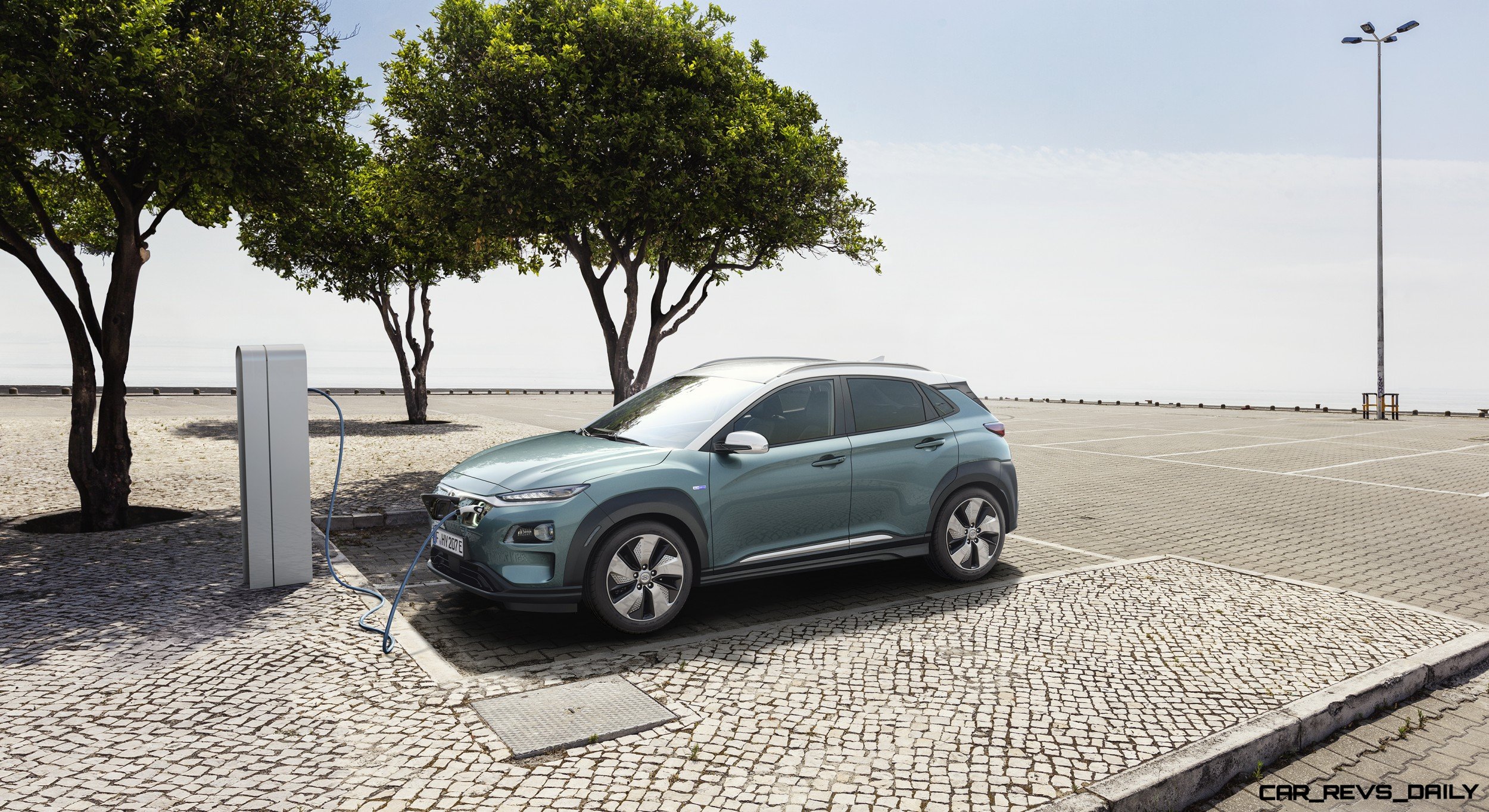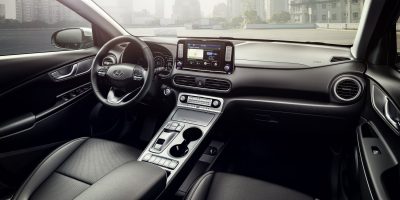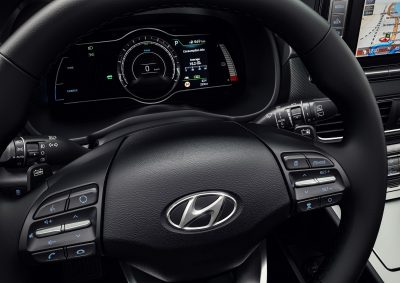Hyundai’s Kona CUV has already made waves since it was introduced a year ago. While it has not set its wheels on U.S. shores as of yet, the Kona has proven to be a popular choice for international buyers. Naturally, Hyundai wants to maintain this momentum, and has unveiled the next iteration of Kona, the Kona Electric.
The exterior styling of the Kona Electric is largely unchanged from the standard Kona, and as a result the majority of the funky lines remain intact. However, there are several minor tweaks that are designed to help the Kona Electric stand out from the rest of its peers. Model exclusive 17-inch alloy wheels help give it a distinctive look, while the closed off front grille improves aerodynamics, and also serves as the biggest indicator of what lurks underneath. The front bumper has also been tweaked, and Hyundai engineers have enhanced aerodynamics even further by adding laterally positioned air curtains to help reduce air turbulence in the wheel wells. Rounding out the look are silver hued side sills, as well as a handsome looking rear spoiler.
The interior of the Kona Electric also shares its basic design with the standard Kona, but a fully digital instrument cluster is on hand, as well as power adjustable heated/ventilated front seats with eight way power adjustment. It’s pretty evident that Hyundai is positioning the Kona Electric as a decidedly more luxurious option for buyers, especially since the driver’s seat features 2-way adjustable lumbar support with separately operated heating element. With these features, it should stand out from other electric offerings, though it will be interesting to see what the final price tag will be for a fully loaded example.
Performance for the Kona Electric will depend on which of the two trim levels that buyers choose. the base Kona Electric features an electric motor that is good for 133 horsepower, as well as 291 lb-ft of torque which is available instantly. A 39.2-kWh battery pack provides enough juice for 186 miles of driving range which was graded based on the new Worldwide harmonized Light vehicles Test Procedure (WLTP). This new standard is is widely considered to be more relevant than the current New European Driving Cycle Standard. (NEDC) Buyers that want more performance to go with their fuel saving purchase can step up to the top tier Kona Electric model, and be rewarded with a 201 horsepower version of the electric motor, which retains the torque figure that also sees duty in the base model. A much bigger 64-kWh battery pack is on tap, and that allows this particular blend of Kona to achieve a much higher driving range of 292 miles per the WLTP standard.
When both battery packs are eventually depleted and need to be “refilled,” buyers will be wise to invest in the optional quick charge systems that Hyundai will be offering. The Korean car giant claims that without it, the base Kona Electric needs just over 6 hours to fully charge its 39.2-kWh battery pack. Meanwhile, the beefier battery pack takes a whopping 9 hours to fully charge its cells with juice. When hooked up to a quick charging port, both models can “fill up” the batteries to 80 percent charge in just under 54 minutes.
The standard Kona is not exactly known for its performance chops, and those expecting a revelation with the Kona Electric will be bitterly disappointed. The base Kona Electric makes the sprint to 62 mph in a decent albeit leisurely 9.3 seconds. This is about on par with some of its rivals, but the exception to the rule is the beefier Kona model which does the same task in a decidedly more brisk 7.3 seconds. This figure is better than some hot hatchbacks, and would give this blend of Kona Electric some sizzle, especially in a straight line.
Unlike other electric offerings that sacrifice interior space for the placement of their battery packs, Hyundai claims that the Kona’s platform allowed them to neatly integrate the battery pack into the floor area of the vehicle. This seamless placement does wonders for the Kona’s cargo capacity, with the Kona Electric boasting a rather impressive 373 liters of outright storage without its charging cable on board. When the cable is along for the ride, this figure decreases slightly to a still commendable 332 liters of storage. With Hyundai boasting that this is the world’s first “electric subcompact crossover” it is good to see that practicality (a CUV must have) has not been sacrificed for the sake of futuristic gimmickry.
Hyundai will have the Kona Electric on display at the Geneva Motor Show on March 6th, it’s unknown if the Kona Electric will join the standard Kona in its trek to U.S. shores, but with the strong popularity of the Ioniq and Kia Niro, we would not be shocked if Hyundai makes it a trio with a U.S. spec version. In the meantime, Hyundai has released a brief video highlighting the Kona Electric, which can be seen below. Oh and spoiler alert, we wish the nifty hologram narrator is included with vehicle purchase.

Carl Malek has been an automotive journalist for over 10 years. First starting out as a freelance photographer before making the transition to writing during college, his work has appeared on numerous automotive forums as well as websites such as Autoshopper.com.
Carl is also a big fan of British vehicles with the bulk of his devotion going to the Morgan Motor Company as well as offerings from Lotus, MG, and Caterham. When he is not writing about automobiles, Carl enjoys spending time with his family and friends in the Metro Detroit area, as well as spending time with his adorable pets.



